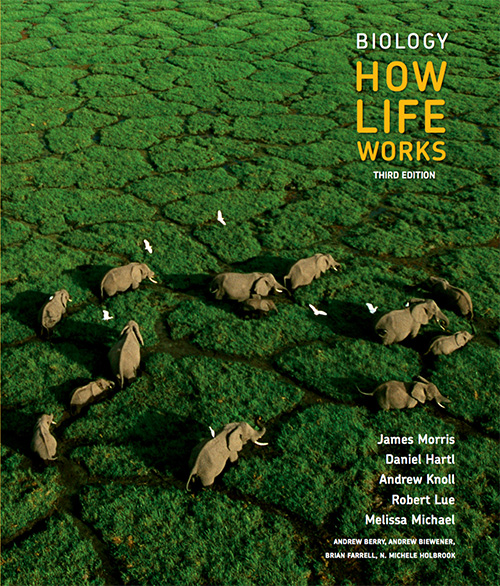James Morris
 Professor of Biology
Professor of Biology
I am interested in evolution, genetics, epigenetics, history of science, and science education. I pursue these diverse interests by focusing on teaching, learning, and research.
Courses
I teach courses for majors and non-majors at Brandeis, including:
- BIOL 16a Evolution and Biodiversity
- BIOL 43b Comparative Vertebrate Anatomy
- BIOL 60b Evolution
- BIOL 124b Epigenetics
- BIOL 155a Project Laboratory in Genetics and Genomics
- BISC 7a The Biology and Culture of Deafness
- FYS 41a Darwin’s On the Origin of Species
Biology 16a Evolution and Biodiversity is part of the introductory biology sequence, along with Biology 14a Genetics and Genomics, and Biology 15b Cells and Organisms. Evolution is the unifying theory of biology. It explains so much about the living world, including the unity and diversity of life. This is why the geneticist Theodosius Dobzhansky remarked, “Nothing in biology makes sense except in the light of evolution.”
I also teach Biology 43b Comparative Vertebrate Anatomy. In this class, we take a broad view of anatomy, including embryology, development, evolution, and the relationship between structure and function. We take time in this class to do dissections, providing an active, experential approach to the study of anatomy. We also explore clinical cases as a way to integrate different organ systems and consider their roles in health and disease.
I am particularly excited about Biology 155a Project Laboratory in Genetics and Genomics. This and other project lab courses give undergraduates a chance to do a genuine, laboratory-based research project in the context of a semester-long course. We also focus on reading and writing research papers. There are project labs focusing on genetics, neurobiology and behavior, cell biology, biochemistry, and biotechnology.
Research
For decades, DNA has been the focus of studies of gene expression and inheritance. More recently, researchers are looking beyond DNA by studying a diverse set of phenomena that are called epigenetic. These processes result in stable, sometimes heritable changes in gene expression, but are often reversible and responsive to the environment. They do not result from changes in DNA sequence, but instead from modifications to DNA bases, histones, chromatin, and chromosome structure. Examples include imprinting, X-inactivation, trans-gene silencing, co-suppression, and paramutation.
My lab focuses on an epigenetic phenomenon known as transvection, and uses the fruit fly Drosophila melanogaster as a model organism. Homologous chromosomes in Drosophila are physically aligned and paired in somatic cells. The expression of some genes is sensitive to chromosome pairing. This pairing sensitivity in gene expression is known as a transvection effect. Transvection has been documented at many genes in Drosophila, and related processes have been described in many organisms, including fungi, plants, and mammals. The study of transvection has provided insights into chromatin and chromosome structure, as well as the organization of chromosomes in the nucleus.
I pursue this research with undergraduates in Biology 155a Project Laboratory in Genetics and Genomics. In addition, undergraduate and Master’s students do independent research in my laboratory.
Biology Education
 I am an author of a college-level introductory biology textbook titled Biology: How Life Works with co-authors Dan Hartl, Andy Knoll, Rob Lue, Melissa Michael, Andrew Berry, Andy Biewener, Brian Farrell, and Missy Holbrook. With all of the recent and exciting changes in biology, education, and technology, we developed a set of resources from the ground up that is relevant to today’s students. Our goal is to move away from an emphasis on terms and facts, and instead convey concepts and ways of thinking that scientists use to understand the world around them and solve contemporary problems.
I am an author of a college-level introductory biology textbook titled Biology: How Life Works with co-authors Dan Hartl, Andy Knoll, Rob Lue, Melissa Michael, Andrew Berry, Andy Biewener, Brian Farrell, and Missy Holbrook. With all of the recent and exciting changes in biology, education, and technology, we developed a set of resources from the ground up that is relevant to today’s students. Our goal is to move away from an emphasis on terms and facts, and instead convey concepts and ways of thinking that scientists use to understand the world around them and solve contemporary problems.
Awards and Honors
- Macmillan STEM product of the Year, Biology: How Life Works, 2017
- National Academies Education Mentor in the Life Sciences, 2014-2015
- Davis Educational Foundation Teaching and Learning Fellow, 2014-2015
- Louis Dembitz Brandeis Prize for Excellence in Teaching, Brandeis University, 2013
- Letter of Commendation for Distinguished Teaching, Harvard Extension School, 2013
- National Academies Education Fellow in the Life Sciences, 2012-2013
- “Professor I Learned the Most From” Award, senior class, Brandeis University, 2011
- Letter of Commendation for Distinguished Teaching, Harvard Extension School, 2006
- Letter of Commendation for Distinguished Teaching, Harvard Extension School, 2005
- Certificate of Distinction in Teaching, Biological Sciences 50, Harvard College, 2003-2004
- Certificate of Distinction in Teaching, Biological Sciences 57, Harvard College, 2003-2004
- Certificate of Distinction in Teaching, Biological Sciences 57, Harvard College, 2002-2003
Brandeis Department and Program Affiliations
Publications
- Morris, D. Hartl, A. Knoll, R. Lue, M. Michael, A. Berry, A. Biewener, B. Farrell, N. M. Holbrook, Biology: How Life Works. 3rd edition. New York: Macmillan Learning, 2019.
- Lax, J. Morris, B. J. Kolber. A partial flip classroom exercise in a large introductory general biology course increases performance at multiple levels. Journal of Biological Education (2016) 51: 412-426.
- Morris, A. Berry, J. Costa. Using the Origin to Teach Biology and Writing. Evolution (2015) 69: 2556-2560.
- Nagakura, G. Schneider, J. Morris, K. A. Lafferty, C. G. Palmer. Assessing Deaf Awareness Training: Knowledge and Attitudes of Recent Genetic Counseling Graduates. J. Genet. Counsel. (2015) 24: 104-116.
- M. Hohl, M. Thompson, A. A. Shoshnev, J. Wu, J. Morris, T. S. Hsieh, C.-t. Wu, P. K. Geyer. Restoration of Topoisomerase 2 Function by Complementation of Defective Monomers in Drosophila. Genetics(2012) 192: 843-856.
- A. Ou, E. Chang*, S. Lee*, K. So*, C.-t. Wu, and J. R. Morris. Effects of chromosomal rearrangements on transvection at the yellow gene of Drosophila melanogaster. Genetics (2009) 183: 483-496.
- L. Perlman and J. R. Morris. What the IPCC Said: A Citizens’ Guide to the IPCC Summary for Policymakers. Washington, D. C.: Island Press, 2007.
- R. Morris, T. Jehn, E. Pantages, C. Vaughan, T. Torello, M. Buchelli, D. Lohman, and R. Lue. A Student’s Guide to Writing in the Life Sciences. Harvard University, 2007.
- R. Morris, D. A. Petrov, A. M. Lee, and C.-t. Wu. Enhancer choice in cis and in trans in Drosophila melanogaster: role of the promoter. Genetics (2004) 167: 1739-1747.
- C.-t. Wu and J. R. Morris. Genes, genetics, and epigenetics: a correspondence. Science (2001) 293: 1103-1105.
- D. Kaplan, J. R. Morris, C.-t. Wu, and F. Winston. Spt5 and Spt6 are associated with active transcription and have characteristics of general elongation factors in Drosophila melanogaster. Genes & Dev. (2000) 14: 2623-2634.
- C.-t. Wu and J. R. Morris. Transvection and other homology effects. Curr. Opin. Genet. Dev. (1999) 9: 237-246.
- R. Morris, P. K. Geyer, and C.-t. Wu. Core promoter elements can regulate transcription on a separate chromosome in trans. Genes & Dev. (1999) 13: 253-258.
- R. Morris, J.-l Chen, S. T. Filandrinos, R. C. Dunn, R. Fisk, P. K. Geyer, and C.-t. Wu. An analysis of transvection at the yellow locus of Drosophila melanogaster. Genetics (1999) 151: 633-651.
- R. Morris, J.-l. Chen, P. K. Geyer, and C.-t. Wu. Two modes of transvection: enhancer action in trans and bypass of a chromatin insulator in cis. Proc. Natl. Acad. Sci. USA. (1998) 95: 10740-10745.
* Brandeis undergraduate